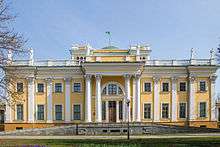Gomel Palace

The Rumyantsev-Paskevich Residence[1] is the main place of historical importance in the city of Gomel, Belarus. The grounds of the residence stretch for 800 meters along the steep right bank of the Sozh River. An image of the residence is featured on the Belarusian 20,000-ruble bill.
The two-storey palace of Field Marshal Pyotr Rumyantsev was built between 1777 and 1796[2] to a Neoclassical design attributed to Ivan Starov. The palace replaced the ruined castle of Gomel's previous owner, Michael Frederick Czartoryski.[3] The central part is surmounted by a square belvedere with a wide flat dome. The six-columned Corinthian portico faces an extensive English park. The main portico is placed on a high platform and is supported by four Corinthian columns.
After Pyotr Rumyantsev's death in 1796, the grounds were slowly improved by his son Nicholas (1754-1826). His brother Sergei was the next owner. He was never interested in country housekeeping and promptly sold the palace to the crown (1834). Gomel was immediately purchased by another Field Marshal, Ivan Paskevich, who had both the palace and the park substantially renovated. He employed architect Adam Idźkowski to add a four-storey tower and a three-storey wing to the existing structure.[4]

After the Russian Revolution the palace was nationalized to house a local museum. Paskevich's daughter-in-law Irina had to move from the palace into an ordinary flat. The buildings sustained heavy damage in the Russian Civil War and World War II.[5] They were shared by the Gomel History Museum and the local pioneers' palace until the late 1990s. The current Neoclassical interiors result from a late 1990s restoration campaign.
The park contains a modern statue of Count Nikolay Rumyantsev. The original marble statues of Euripides, Venus, Athena, Ares, Bacchus, and the Nymph were lost. It was only in 2006 that the replacement statues were put in place. The Paskevich art collection also boasted several paintings by Ivan Kramskoi, Marcin Zaleski, and January Suchodolski, as well as a marble bust of Count Rumyantsev by Antonio Canova.[6]
The bronze equestrian statue of Prince Joseph Poniatowski by Bertel Thorvaldsen, which Paskevich had brought from Warsaw as a trophy in 1842, was dismantled by the Poles during the Polish-Soviet War and transported back to Warsaw, only to be destroyed by the Germans in the 1940s.[6] Its copy stands in front of the Presidential Palace, Warsaw.
Other buildings on the grounds are the Russian Revival chapel with the tombs of Ivan Paskevich and his family, a winter garden (which originated as Prince Paskevich's sugar-mill), several subsidiary outbuildings, and a set of cannons captured by Paskevich's soldiers in the course of the Russo-Turkish War (1828–1829).
By far the most conspicuous landmark in the park is the Neoclassical church of Sts. Peter and Paul. It was commissioned by Count Nikolay Rumyantsev from architect John Clark in 1809 but was not consecrated until 1824.[7] The church is the seat of the local Orthodox bishopric.
Other Rumyantsev residences
- Tashan, Ukraine
- Kachanovka
| Wikimedia Commons has media related to Palace of Pashkevichs, Homel. |
References
- ↑ Official website of the Republic of Belarus: Palace of the Rumyantsevs and the Paskeviches in Gomel (English)
- ↑ Official website: Gomel Palace History (Russian)
- ↑ Sequestration of private property in the Gomel region (Russian)
- ↑ Official website of the Rumyantsev-Paskevich Palace (Russian)
- ↑ Rumyantsev-Paskevich Palace (Russian)
- 1 2 Official website: Works by artists from Poland in the museum palace and park ensemble (Russian)
- ↑ Ю. В. Шпит, В. И. Аникин. "Архитектура Советской Белоруссии". Стройиздат, 1973. Стр. 117.
Coordinates: 52°25′20″N 31°00′59″E / 52.42222°N 31.01639°E